Photographs: Adnan Abidi/Reuters Nivedita Mookerji and Dilasha Seth in New Delhi
With a huge debt burden of Rs 22,758 crore (Rs 227.58 billion), DLF is scrambling to sell non-core assets to give itself some breathing room. Will it work?
To say that it has been an annus horribilis for DLF - the country's largest real-estate company - may be an understatement.
Its numbers would make even the most battle-hardened CFO blanche. Its net profits were down 45 per cent in the third quarter of this year when compared to the same period last year - in fact, the company has not posted an increase in quarterly profits in just under two years.
Sales growth has also fallen over the last four quarters. Yet, the most dramatic number that DLF has posted to date is its debt: A staggering Rs 22,758 crore (Rs 227.58 billion) as of end of December 2011.
The group CFO of DLF, Ashok Kumar Tyagi, told said: "Seeing today's market, it will be very foolhardy to speculate on numbers for the long-term. We are focused on two to three years at this point."
Consequently, DLF is in the middle of a strategy to sell its non-core assets to ease the pressure on its books.
...
Will DLF survive its growing debt problem?
Image: The CFO agrees that the debt is high.Photographs: Rupak de Chowdhuri/Reuters
Even as it set a target of raising Rs 6,000 crore (Rs 60 billion) to Rs 7,000 crore (Rs 70 billion) from divesting non-core assets in two years ending financial year 2012-13, the going has been tough so far.
Admitting that some of the big-ticket sales targeted for this financial year will spill over to the next fiscal, thereby delaying the debt reduction programme of the realtor, Tyagi is busy articulating a strategy that can get DLF out of its mess and woo the financial community again.
"The ideal debt level, that guarantees a zero-worry situation, is one that is completely in liquidated form against my rental assets.... That works out to around Rs 12,000 crore (Rs 120 billion) to Rs 14,000 crore (Rs 140 billion) a year. That is the journey that we need to undertake" said Tyagi.
According to him, once DLF reaches a debt level of Rs 17,000 crore (Rs 170 billion) to Rs 17,500 crore (Rs 175 billion), from there on moving to Rs 14,000 crore (Rs 140 billion) will not be difficult.
That, he pointed out, was the medium-term goal of the company.
Although DLF's high debt level has been seen a cause of concern for industry watchers, the DLF group CFO argues that if you are an asset-heavy company, it often results in being a debt-heavy company.
"Yes, we believe the debt is high and we would like to reduce it, and therefore we are focused on non-core sales. But the quantum of debt that you have to carry is usually high if you are an asset-heavy company."
...
Will DLF survive its growing debt problem?
Image: DLF expects to raise around Rs 5,000 crore.Photographs: Punit Paranjpe/Reuters
He added that DLF's debt-equity ratio of 0.8:1 compares reasonably well with most healthy companies. On an average, the minimum capex required in the real-estate business is around Rs 300 crore (Rs 3 billion) to Rs 400 crore (Rs 4 billion) a quarter, according to the company.
Anything beyond that amount that the company raises from non-core asset sale goes into debt reduction. So, if DLF raises Rs 6,000 crore (Rs 60 billion) to Rs 7,000 crore (Rs 70 billion) from non-core sale, it expects the debt level to come down by Rs 5,000 crore.
The easiest way to do that for any company drowning in debt is to hawk assets that are not material to the company's operations - its non-core assets - and that is exactly what DLF is planning to do.
In the next four to five quarters, DLF expects to raise around Rs 5,000 crore (Rs 50 billion) from non-core asset sale.
"Most of our big-ticket sale, including Aman, wind business, and a couple of land parcels, is underway but it will take a few more months to close. We do believe that in the next fiscal all of these transactions should be closed," Tyagi said.
Will that be enough to win over the financial community? Many analysts and brokerage firms tracking the company remain sceptical about the pace of DLF's recovery.
...
Will DLF survive its growing debt problem?
Image: DLF's large cashflow shortfalls is a negative for the company, says an analyst.Photographs: Reuters
"I expect non-core asset sales to happen only in the financial year 2013-14," said one analyst, indicating that the company may find it difficult to shed debt significantly even in 2012-13. "If any sales happen earlier than that, it would be a pleasant surprise," he added.
Another analyst pointed at DLF's "large cashflow shortfalls" as a negative for the company.
While the real estate sector was already in the throes of a slowing demand and inventory pile-up, DLF was slapped a penalty of Rs 630 crore (Rs 6.3 billion) by the competition watchdog CCI halfway through the financial year 2011-12.
This was after a group of up-end DLF apartment owners, at Belaire (Gurgaon), had moved the Competition Commission of India (CCI) for alleged misuse of market leader's position.
More recently, CCI came out with yet another order slamming the realty firm with similar charges in connection with another housing society (Magnolia) complaint - as a saving grace, no fresh penalty was imposed on the company this time.
Besides grappling with the CCI order and other woes ailing the real estate sector, DLF was recently at the receiving end of a damaging report by a Canadian research firm, Veritas.
Analysts Neeraj Monga and Nitin Mangal of Veritas argued the DLF stock should not exceed Rs 100 (while the share was going at over Rs 220) in the best case scenario and called the real estate firm an "organisation under duress" and a "crumbling edifice".
...
Will DLF survive its growing debt problem?
Image: This is a company that has experienced its fair share of highs and lows.Photographs: Reuters
The report triggered a stock crash for DLF on two consecutive days, but the scrip is now bouncing back. DLF rubbished the Veritas report in a statement to the media calling it "mischievous" and "presumptive", and adding that the "audited financials of the company are always in the public domain".
Since the report was released more than 10 days ago, analysts have been divided over whether to give a 'sell' or a 'buy' recommendation to the DLF stock.
This is a company that has experienced its fair share of highs and lows and whose "destiny changed" after the development of Gurgaon, the IT and corporate hub next to Delhi.
In fact, KP Singh, Founder and Chairman, DLF in his autobiography, Whatever The Odds, wrote that he had almost sold DLF way back in 1975 for Rs 26 lakh, and then stopped from doing it at the last moment.
Referring to the economic downturn in 2008-09, he told Business Standard in a recent interview that his son (Rajiv Singh) was quick enough to re-orient the company.
"He has divested some non-core assets and shed manpower. We are still divesting what we believe is not core," Singh said.
He added, "lean, hungry, efficient organisation is how we are looking at DLF. Prosperity is the time to practise austerity, and that's what the company has been doing."
...
Will DLF survive its growing debt problem?
Image: DLF wants to sell some assets to cut its mounting debt.Photographs: Reuters
DLF's investors will hope that this is not mere lip-service to what has become fashionable industry parlance, but a genuine effort to turn things around.
To add to its woes, DLF has not been able to dispose the Aman hotel, which is among the big-ticket assets slated for sale. DLF wants to sell Aman, barring its Delhi hotel, to cut its mounting debt.
Yet, KP Singh said that the company "would be able to overcome the slowing economy and the challenges in the realty sector", with son Rajiv Singh firmly on the driver's seat.
Even as a lot depends on the Aman sale, the company is tight-lipped on the expectation from the deal. The buzz has been that DLF is looking to realise over Rs 2,000 crore (Rs 20 billion) from Aman.
Out of the Rs 6,000 crore (Rs 60 billion) to Rs 7,000 crore (Rs 70 billion) targeted from non-core sales by end of 2012-13, DLF has raised just Rs 1,600 crore (Rs 16 billion) this financial year. In the coming financial year, therefore, the company needs to raise anything between Rs 4,500 crore (Rs 45 billion) and Rs 5,500 crore (Rs 55 billion) from non-core assets to meet the target.
Undoubtedly, the Aman sale will be critical for the company towards that objective. With a land bank of around 350 million sq ft across the country, DLF is exploring ways to unlock value.
It has expressed great confidence about the next financial year as it sees itself at the cusp of a great execution opportunity, besides getting approvals for a large number of residential and mix-use project launches.
...
Will DLF survive its growing debt problem?
Image: The company plans to deliver in excess of 30 million sq ft over the next 18 months.Photographs: Arko Datta/Reuters
The company plans to deliver in excess of 30 million sq ft over the next 18 months. Around 15,000 units will be delivered in Gurgaon, Delhi, Chennai and Kolkata.
The company claims that this scale of delivery has never been seen before in the Indian real estate sector. This will involve third party contract companies like L&T, Shapoorji Pallonji among others.
DLF is also of the view that both interest cost and overheads should come down as the RBI rate cut happens and the debt level declines. It also claims that it can come back to its full potential in two to three quarters, in sync with the expected revival of the economy as well as the real estate sector.
For that to happen, the company will have to keep its head down and stick to its plan of generating cash if it hopes to have any chance of capitalising on a resurgence in the country's economic fundamentals.

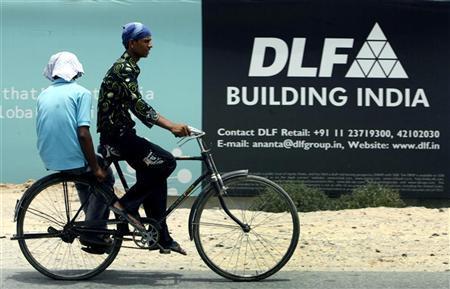
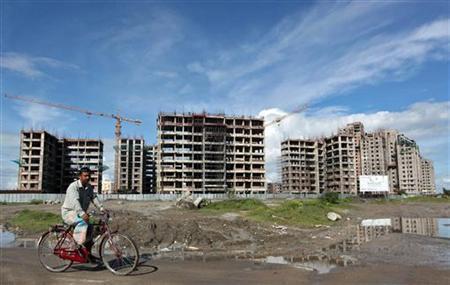
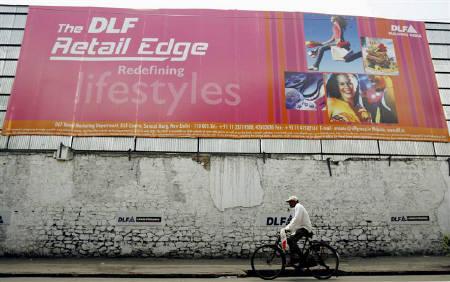
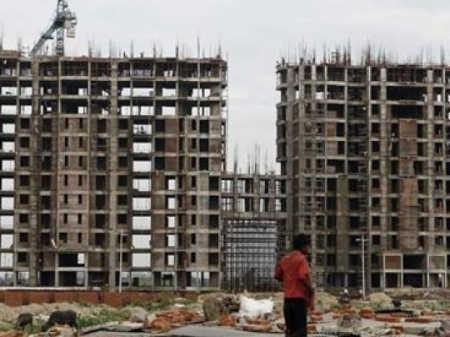

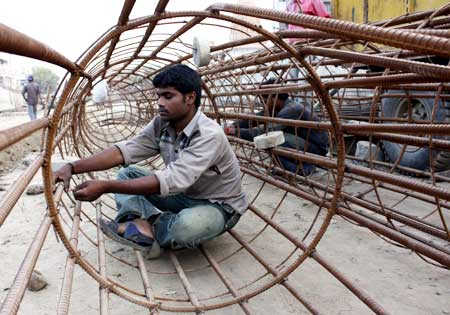


article